Researchers confirm invasions of biblical Israel using geomagnetic fields

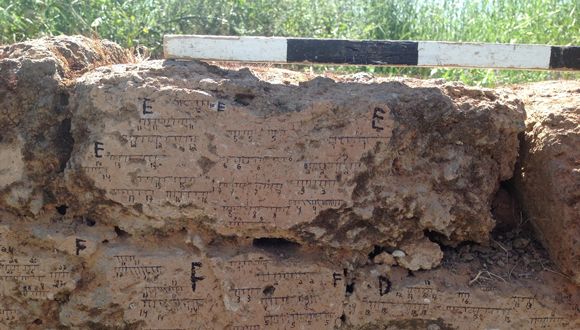
Research
Researchers confirm invasions of biblical Israel using geomagnetic fields

A joint study by TAU and the Hebrew University, involving 20 researchers from different countries and disciplines, has accurately dated 21 destruction layers at 17 archaeological sites in Israel by reconstructing the direction and/or intensity of the earth's magnetic field recorded in burnt remnants. The new data verify the Biblical accounts of the Egyptian, Aramean, Assyrian, and Babylonian military campaigns against the Kingdoms of Israel and Judah.
Findings indicate, for example, that the army of Hazael, King of Aram-Damascus, was responsible for the destruction of several cities - Tel Rehov, Tel Zayit, and Horvat Tevet, in addition to Gath of the Philistines, whose destruction is noted in the Hebrew Bible. At the same time, the study refutes the prevailing theory that Hazael was the conqueror who destroyed Tel Beth-Shean.
Other geomagnetic findings reveal that the cities in the Negev were destroyed by the Edomites, who took advantage of the destruction of Jerusalem and the Kingdom of Judah by the Babylonians.
The groundbreaking interdisciplinary study was published in PNAS (Proceedings of the National Academy of Sciences of the USA) and is based on the doctoral thesis of Yoav Vaknin, supervised by Prof. Erez Ben-Yosef and Prof. Oded Lipschits of TAU's Nadler Institute of Archaeology and Prof. Ron Shaar from the Institute of Earth Sciences at the Hebrew University.
The researchers explain that geophysicists, attempting to understand the mechanism of earth's magnetic field, track changes in this field throughout history. To this end, they use archaeological findings containing magnetic minerals which, when heated or burned, record the magnetic field at the time of the fire.
Thus, in a 2020 study, researchers reconstructed the magnetic field as it was on the 9th of the month of Av, 586 BCE, the Hebrew date of the destruction of the First Temple and the City of Jerusalem by Nebuchadnezzar and his Babylonian army.
Now, using archaeological findings unearthed over several decades at 17 sites throughout Israel, alongside historical information from ancient inscriptions and Biblical accounts, the researchers were able to reconstruct the magnetic fields recorded in 21 destruction layers. They used the data to develop a reliable new scientific tool for archaeological dating.
Yoav Vaknin explains: "Based on the similarity or difference in intensity and direction of the magnetic field, we can either corroborate or disprove hypotheses claiming that specific sites were burned during the same military campaign. Moreover, we have constructed a variation curve of field intensity over time which can serve as a scientific dating tool, similar to the radiocarbon dating method."

Yoav Vaknin measuring at the site (Photo: Shai Halevi, Israel Antiquities Authority)
One example given by the researchers is the destruction of Gath of the Philistines (identified today as Tel Tzafit in the Judean foothills) by Hazael, King of Aram-Damascus. Various dating methods have placed this event at around 830 BCE but were unable to verify that Hazael was also responsible for the destruction of Tel Rehov, Tel Zayit and Horvat Tevet.
The new study, identifying full statistical synchronization between the magnetic fields recorded at all these four sites at the time of destruction, now makes a very strong case for their destruction having taken place during the same campaign.
A destruction level at Tel Beth-Shean, on the other hand, recording a totally different magnetic field, refutes the prevailing hypothesis that it too was destroyed by Hazael. Instead, the magnetic data from Beth-Shean indicate that this city, along with two other sites in northern Israel, was probably destroyed 70-100 years earlier, a date which could correspond with the military campaign of the Egyptian Pharaoh Shoshenq.
Shoshenq's campaign is described in the Hebrew Bible and in an inscription on a wall of the Temple of Amun in Karnak, Egypt, which mentions Beth-Shean as one of his conquests.
"While Jerusalem and frontier cities in the Judean foothills ceased to exist, other towns in the Negev, the southern Judean Mountains and the southern Judean foothills remained almost unaffected. Now, the magnetic results support this hypothesis, indicating that the Babylonians were not solely responsible for Judah's ultimate demise." Prof. Erez Ben Yosef
One of the most interesting findings revealed by the new dating method has to do with the end of the Kingdom of Judah. Prof. Erez Ben Yosef: "The last days of the Kingdom of Judah are widely debated. Some researchers, relying on archaeological evidence, argue that Judah was not completely destroyed by the Babylonians. While Jerusalem and frontier cities in the Judean foothills ceased to exist, other towns in the Negev, the southern Judean Mountains and the southern Judean foothills remained almost unaffected. Now, the magnetic results support this hypothesis, indicating that the Babylonians were not solely responsible for Judah's ultimate demise."
"Several decades after they had destroyed Jerusalem and the First Temple, sites in the Negev, which had survived the Babylonian campaign, were destroyed – probably by the Edomites who took advantage of the fall of Jerusalem. This betrayal and participation in the destruction of the surviving cities may explain why the Hebrew Bible expresses so much hatred for the Edomites - for example, in the prophecy of Obadiah."
Prof. Oded Lipschits adds that "the new dating tool is unique because it is based on geomagnetic data from sites, whose exact destruction dates are known from historical sources. By combining precise historical information with advanced, comprehensive archaeological research, we were able to base the magnetic method on reliably anchored chronology."

Burnt mud stones
"Until recently scientists believed that [the magnetic field] remains quite stable for decades, but archaeomagnetic research has contradicted this assumption by revealing some extreme and unpredictable changes in antiquity." Prof. Ron Shaar
Prof. Ron Shaar, who led the geophysical aspects of the study, as well as the development of the geomagnetic dating method, explains: "Earth's magnetic field is critical to our existence. Most people don't realize that without it there could be no life on earth - since it shields us from cosmic radiation and the solar wind. In addition, both humans and animals use it to navigate."
"The geomagnetic field is generated by earth's outer core, at a depth of 2,900 km, by currents of liquid iron. Due to the chaotic motion of this iron, the magnetic field changes over time. Until recently scientists believed that it remains quite stable for decades, but archaeomagnetic research has contradicted this assumption by revealing some extreme and unpredictable changes in antiquity."
"Our location here in Israel is uniquely conducive to archaeomagnetic research, due to an abundance of well-dated archaeological findings. Over the past decade we have reconstructed magnetic fields recorded by hundreds of archaeological items. By combining this dataset with the data from Yoav’s investigation of historical destruction layers, we were able to form a continuous variation curve showing rapid, sharp changes in the geomagnetic field. This is wonderful news, both for archaeologists, who can now use geomagnetic data to determine the age of ancient materials, and for geophysicists studying the earth's core."
A separate paper, presenting the scientific principles of the novel archaeomagnetic dating method, is in preparation.
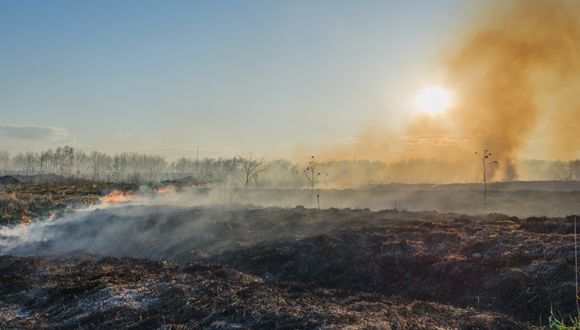
Research
Their activities destroyed local vegetation for the copper industry

Humans destroying ecosystems apparently dates as far back as to biblical times: Researchers from Tel Aviv University collected samples of charcoal used as fuel for metallurgical furnaces in the Timna Valley, located in Israel’s southern desert region, during the 11th-9th centuries BCE and examined them under a microscope. They found that the charcoal fuels used changed over time. The earlier samples contained mainly local white broom and acacia thorn trees, excellent fuel available nearby, but the quality of the firewood had deteriorated over time, with later samples consisting of low-quality wood fuel and timber imported from afar.
The researchers: "Our findings indicate that the ancient copper industry at Timna was not managed in a sustainable manner, with overexploitation of local vegetation eventually leading to the disappearance of both the plants and the industry. Copper production was not renewed in this region until about a thousand years later, and the local environment has not recovered fully to this day."
"We can only assume that [King] David took an interest in this remote desert region because of its copper – an important and valuable metal at the time, used for making bronze among other purposes."
The study was conducted by PhD student Mark Cavanagh, Prof. Erez Ben-Yosef, and Dr. Dafna Langgut, head of the Laboratory of Archaeobotany and Ancient Environments, all from TAU's Jacob M. Alkow Department of Archaeology and Ancient Near Eastern Cultures, and Dr. Langgut is also affiliated with the Steinhardt Museum of Natural History. The study was published in the prestigious journal Scientific Reports from the Nature portfolio.
"Many findings in the Timna Valley indicate that a vast copper industry flourished here for a period of about 250 years, between the 11th and 9th centuries BCE, with thousands of mining sites, and about 10 processing sites that used furnaces to extricate copper from the ore," says Prof. Erez Ben-Yosef, director of the archaeological excavations in the Timna Valley. "This impressive operation is known to the public as 'King Solomon's Mines', and today we know that copper production peaked here at about the time of Kings David and Solomon."
"The Bible never mentions the mines as such, but it does tell us that David conquered the area of Timna, known at the time as Edom, placing garrisons throughout the land, so that the Edomites became his subjects; and that his son Solomon used huge quantities of copper for building the Temple in Jerusalem. We can only assume that David took an interest in this remote desert region because of its copper – an important and valuable metal at the time, used for making bronze among other purposes. The Timna copper industry was run by the local Edomites, who specialized in this profession, and copper from Timna was exported to distant lands, including Egypt, Lebanon, and even Greece. This study shows, however, that the industry was not sustainable, a fact that may fit in well with occupation by a foreign power, perhaps ruled from Jerusalem."
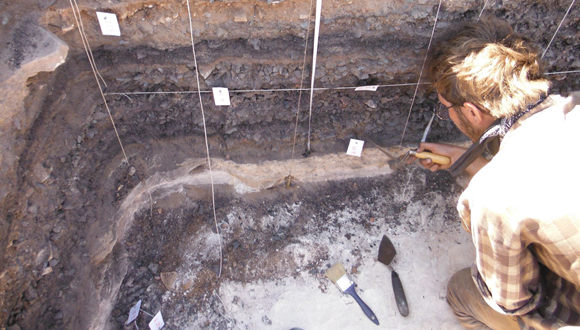
Investigating a pile of industrial waste mixed with charcoal on Slaves’ Hill, Timna Valley (photo: Erez Ben-Yosef and the Central Timna Valley Project)
The researchers explain that Timna's copper industry was highly advanced for its time, and that the metalsmiths who processed the copper were skilled and well-respected individuals.
The copper was extracted from the ore via smelting in earthenware furnaces at a temperature of 1,200 degrees Celsius. The entire process took about eight hours, after which the furnace was smashed, and the copper retrieved from its base. The wood charcoal required to attain the high temperature was manufactured beforehand at special sites, by slow combustion of trees and bushes cut down for this purpose.
Ever since the copper industry at Timna was first discovered, about 200 years ago, researchers have repeatedly asked what fuel was used to heat the smelting furnaces. Since vegetation is very sparse in this desert area, where did the firewood come from?
"In order to finally solve this mystery, we collected samples of charcoal from the smelting sites and examined them in the lab," says Mark Cavanagh. The charcoal samples, well-preserved thanks to the dry desert climate, were taken from mounds of industrial waste at two large production sites in the Timna Valley and brought to the archaeobotanical laboratory at TAU.
"At the lab we examine plant remains discovered at archeological excavations," explains Dr. Dafna Langgut. "In the present study we examined more than 1,000 charcoal samples under an electronic microscope. The anatomic structure of the original wood is preserved in the charcoal, and under the microscope the species can be identified. The samples were dated according to the layer of the waste mound in which they had been found, and some were also sent out for carbon-14 dating."
"The production site called the 'Slaves’ Hill' (…) burned as many as 400 acacias and 1,800 brooms every year. As these resources dwindled, the industry looked for other solutions, as evidenced by the changing composition of the charcoal."
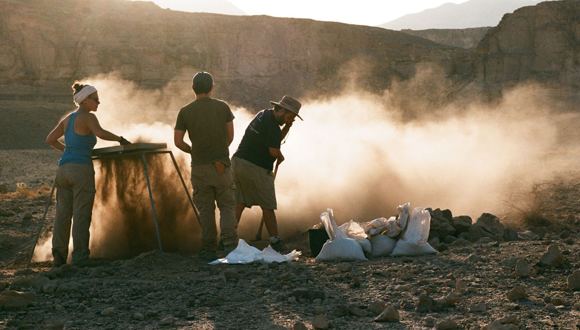
Excavating Slaves’ Hill (photo: Hai Ashkenazi, courtesy of the Central Timna Valley Project)
Mark Cavanagh describes the findings: "We found significant changes in the composition of the charcoal as time went on. Charcoal from the bottom layer of the mounds, dated to the 11th century BCE, mostly contained two plants known to be excellent burning materials: 40% acacia thorn trees, and 40% local white broom, including broom roots. The 'burning coals of the broom tree' are even mentioned in the Bible as excellent firewood (Psalm 120, 4). About 100 years later, around the middle of the 10th century BCE, we saw a change in the makeup of the charcoal. The industry had begun to use fuel of a lower quality, such as various desert bushes and palm trees. In this latter stage, other trees were imported from far away, such as junipers from the Edomite plateau in present-day Jordan, covering distances of up to 100 km from Timna, and terebinth, also transported from dozens of kilometers away."
The researchers claim that the gradual change in the contents of the charcoal resulted from overexploitation that had destroyed the natural resources – in this case high-quality firewood, the acacia and white broom.
Prof. Ben-Yosef: "Based on the amount of industrial waste found at the processing sites we can calculate the quantity of woody plants required for producing copper. For example, the production site called the 'Slaves’ Hill', which was only one of several sites operating simultaneously, burned as many as 400 acacias and 1,800 brooms every year. As these resources dwindled, the industry looked for other solutions, as evidenced by the changing composition of the charcoal. However, transporting woody plants from afar did not prove cost-effective for the long run, and eventually, during the 9th century BCE, all production sites were shut down. The copper industry in the Timna Valley was renewed only 1,000 later, by the Nabateans."
Dr. Langgut concludes: "Our study indicates that 3,000 years ago humans caused severe environmental damage in the Timna Valley, which affects the area to this day. The damage was caused through overexploitation, especially of the acacia and white broom, which, as key species in the ecosystem of the Southern Arava, had supported many other species, stored water, and stabilized the soil. Their disappearance generated a domino effect of environmental damage, irreparably harming the entire area. Three thousand years later, the local environment still hasn't recovered from the crisis. Some species, like the white broom, once prevalent in the Timna Valley, are now very rare, and others have disappeared forever."

Tel Aviv University's Dr. Dafna Langgut and Prof. Erez Ben-Yosef
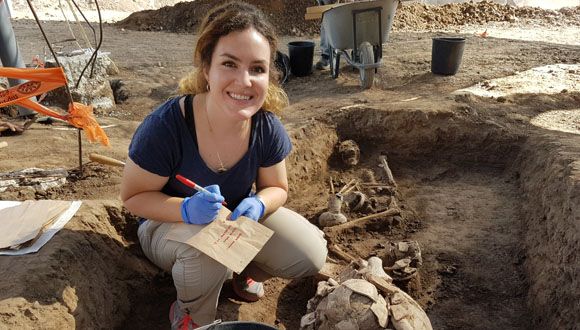
Research
Opium residue was found in Israel, dating back to the 14th century BC. Researchers believe Canaanites used the psychoactive drug as offering for the dead

A new study by the Israel Antiquities Authority, Tel Aviv University and The Weizmann Institute of Science has revealed the earliest known evidence of the use of the hallucinogenic drug opium, and psychoactive drugs in general, in the world. The opium residue was found in ceramic vessels discovered at Tel Yehud in Israel, in an excavation conducted by Eriola Jakoel on behalf of the Antiquities Authority. The vessels that contained the opium date back to the 14th century BC, and were found in Canaanite graves, apparently having been used in local burial rituals.
This exciting discovery confirms historical writings and archeological hypotheses according to which opium and its trade played a central role in the cultures of the Near East.
The research was conducted as part of Vanessa Linares’ doctoral thesis, under the guidance of Prof. Oded Lipschits and Prof. Yuval Gadot of Tel Aviv University’s Department of Archeology and Prof. Ronny Neumann of the Weizmann Institute, in collaboration with Eriola Jakoel and Dr. Ron Be’eri of the Israel Antiquities Authority. The study was published in the journal Archaeometry.
"Because the vessels are similar in shape to the poppy flower when it is closed and upside down, the hypothesis arose already in the 19th century that they were used as ritual vessels for the drug."
In 2012, the Antiquities Authority conducted a salvage excavation at the Tel Yehud site, prior to the construction of residences there. Several Canaanite graves from the Late Bronze Age were found in the excavation, and next to them burial offerings – vessels intended to accompany the dead into the afterlife.
Among the pottery, a large group of vessels made in Cyprus and referred to in the study as “Base-Ring juglets,” stood out. Because the vessels are similar in shape to the poppy flower when it is closed and upside down, the hypothesis arose already in the 19th century that they were used as ritual vessels for the drug.
Now, an organic residue analysis has revealed opium residue in eight vessels, some local and some made in Cyprus. This is the first time that opium has been found in pottery in general, and in Base-Ring vessels in particular. It is also the earliest known evidence of the use of hallucinogens in the world.
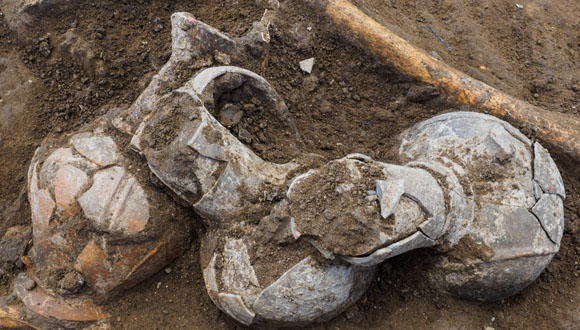
Vessels intended to accompany the dead into the afterlife. These Cypriot jugs and juglets were laid on the deceased. Remains of opium were found in several of the vessels (photo: Assaf Peretz, Israel Antiquities Authority)
"It may be that during these ceremonies, conducted by family members or by a priest on their behalf, participants attempted to raise the spirits of their dead relatives in order to express a request, and would enter an ecstatic state by using opium."
"In the excavations conducted at Tel Yehud to date, hundreds of Canaanite graves from the 18th to the 13th centuries BC have been unearthed," shares Dr. Ron Be’eri of the Israel Antiquities Authority. "Most of the bodies buried were those of adults, of both sexes. The pottery vessels which had been placed within the graves were used for ceremonial meals, rites and rituals performed by the living for their deceased family members."
Beeri explains that the dead were honored with foods and drinks that were either placed in the vessels or consumed during a feast that took place over the grave, at which the deceased was, in fact, considered a participant. It may be that during these ceremonies, conducted by family members or by a priest on their behalf, participants attempted to raise the spirits of their dead relatives to express a request, and would enter an ecstatic state by using opium. Alternatively, he says, the opium, which was placed next to the body, may have been intended to help the spirit of the deceased rise from the grave in preparation for the meeting with their relatives in the next life.
"Canaanites attached great importance to ‘satisfying the needs of the dead’ through ritual ceremonies performed for them by the living, and believed that in return, the spirits would ensure the health and safety of their living relatives"
Vanessa Linares of Tel Aviv University explains: “This is the only psychoactive drug that has been found in the Levant in the Late Bronze Age. In 2020, researchers discovered cannabis residue on an altar in Tel Arad, but this dated back the Iron Age, hundreds of years after the opium in Tel Yehud. Because the opium was found at a burial site, it offers us a rare glimpse into the burial customs of the ancient world. Of course, we do not know what the opium’s role was in the ceremony – whether the Canaanites in Yehud believed that the dead would need opium in the afterlife, or whether it was the priests who consumed the drug for the purposes of the ceremony."
"Moreover, the discovery sheds light on the opium trade in general. One must remember that opium is produced from poppies, which grew in Asia Minor – that is, in the territory of current-day Turkey – whereas the pottery in which we identified the opium were made in Cyprus. In other words, the opium was brought to Yehud from Turkey, through Cyprus; this of course indicates the importance that was attributed to the drug.”
Dr. Ron Be’eri of the Antiquities Authority adds, “Until now, no written sources have been discovered that describe the exact use of narcotics in burial ceremonies, so we can only speculate what was done with opium. From documents that were discovered in the Ancient Near East, it appears that the Canaanites attached great importance to ‘satisfying the needs of the dead’ through ritual ceremonies performed for them by the living, and believed that in return, the spirits would ensure the health and safety of their living relatives.”
According to Eli Eskosido, director of the Israel Antiquities Authority, “New scientific capabilities have opened a window for us to fascinating information and have provided us with answers to questions that we never would have dreamed of finding in the past. One can only imagine what other information we will be able to extract from the underground discoveries that will emerge in the future.”
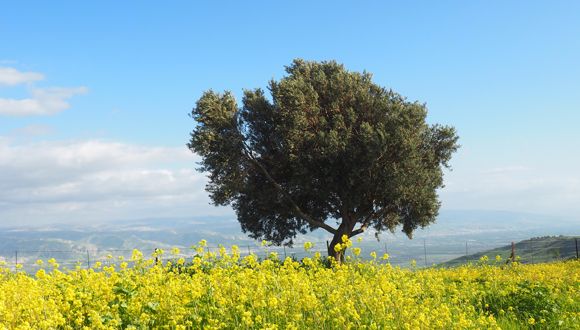
Research
Earliest evidence for cultivation of a fruit tree, according to researchers

A joint study by researchers from Tel Aviv University and the Hebrew University unraveled the earliest evidence for domestication of a fruit tree. The researchers analyzed remnants of charcoal from the Chalcolithic site of Tel Zaf in the Jordan Valley and determined that they came from olive trees. Since the olive did not grow naturally in the Jordan Valley, this means that the inhabitants planted the tree intentionally about 7,000 years ago. Some of the earliest stamps were also found at the site, and as a whole, the researchers say the findings indicate wealth, and early steps toward the formation of a complex multilevel society.
The groundbreaking study was led by Dr. Dafna Langgut of the The Jacob M. Alkow Department of Archaeology & Ancient Near Eastern Cultures, The Sonia & Marco Nadler Institute of Archaeology and the Steinhardt Museum of Natural History at Tel Aviv University. The charcoal remnants were found in the archaeological excavation directed by Prof. Yosef Garfinkel of the Institute of Archaeology at the Hebrew University. The findings were published in the journal Scientific Reports from the publishers of Nature.
According to Dr. Langgut, Head of the Laboratory of Archaeobotany & Ancient Environments which specializes in microscopic identification of plant remains, “trees, even when burned down to charcoal, can be identified by their anatomic structure. Wood was the 'plastic' of the ancient world. It was used for construction, for making tools and furniture, and as a source of energy. That's why identifying tree remnants found at archaeological sites, such as charcoal from hearths, is a key to understanding what kinds of trees grew in the natural environment at the time, and when humans began to cultivate fruit trees."
In her lab, Dr. Langgut identified the charcoal from Tel Zaf as belonging to olive and fig trees. "Olive trees grow in the wild in the land of Israel, but they do not grow in the Jordan Valley," she says. "This means that someone brought them there intentionally – took the knowledge and the plant itself to a place that is outside its natural habitat. In archaeobotany, this is considered indisputable proof of domestication, which means that we have here the earliest evidence of the olive's domestication anywhere in the world.”
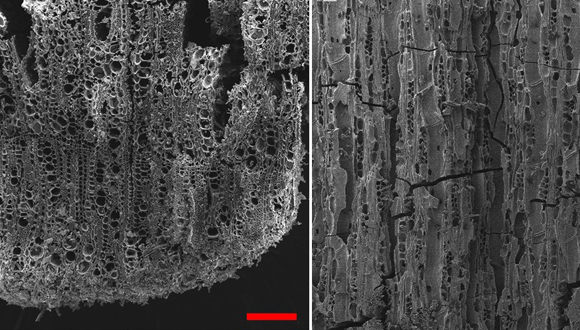
7,000 years-old microscopic remains of charred olive wood (Olea) recovered from Tel Tsaf (Photo: Dr. Dafna Langgut)
“I also identified many remnants of young fig branches. The fig tree did grow naturally in the Jordan Valley, but its branches had little value as either firewood or raw materials for tools or furniture, so people had no reason to gather large quantities and bring them to the village. Apparently, these fig branches resulted from pruning, a method still used today to increase the yield of fruit trees."
The tree remnants examined by Dr. Langgut were collected by Prof. Yosef Garfinkel of the Hebrew University, who headed the dig at Tel Zaf. Prof. Garfinkel: "Tel Zaf was a large prehistoric village in the middle Jordan Valley south of Beit She'an, inhabited between 7,200 and 6,700 years ago. Large houses with courtyards were discovered at the site, each with several granaries for storing crops. Storage capacities were up to 20 times greater than any single family's calorie consumption, so clearly these were caches for storing great wealth. The wealth of the village was manifested in the production of elaborate pottery, painted with remarkable skill. In addition, we found articles brought from afar: pottery of the Ubaid culture from Mesopotamia, obsidian from Anatolia, a copper awl from the Caucasus, and more."
Dr. Langgut and Prof. Garfinkel were not surprised to discover that the inhabitants of Tel Zaf were the first in the world to intentionally grow olive and fig groves, since growing fruit trees is evidence of luxury, and this site is known to have been exceptionally wealthy.
Dr. Langgut: "The domestication of fruit trees is a process that takes many years, and therefore befits a society of plenty, rather than one that struggles to survive. Trees give fruit only 3-4 years after being planted. Since groves of fruit trees require a substantial initial investment, and then live on for a long time, they have great economic and social significance in terms of owning land and bequeathing it to future generations – procedures suggesting the beginnings of a complex society. Moreover, it's quite possible that the residents of Tel Zaf traded in products derived from the fruit trees, such as olives, olive oil, and dried figs, which have a long shelf life. Such products may have enabled long-distance trade that led to the accumulation of material wealth, and possibly even taxation – initial steps in turning the locals into a society with a socio-economic hierarchy supported by an administrative system."
Dr. Langgut concludes: "At the Tel Zaf archaeological site we found the first evidence in the world for the domestication of fruit trees, alongside some of the earliest stamps – suggesting the beginnings of administrative procedures. As a whole, the findings indicate wealth, and early steps toward the formation of a complex multilevel society, with the class of farmers supplemented by classes of clerks and merchants."